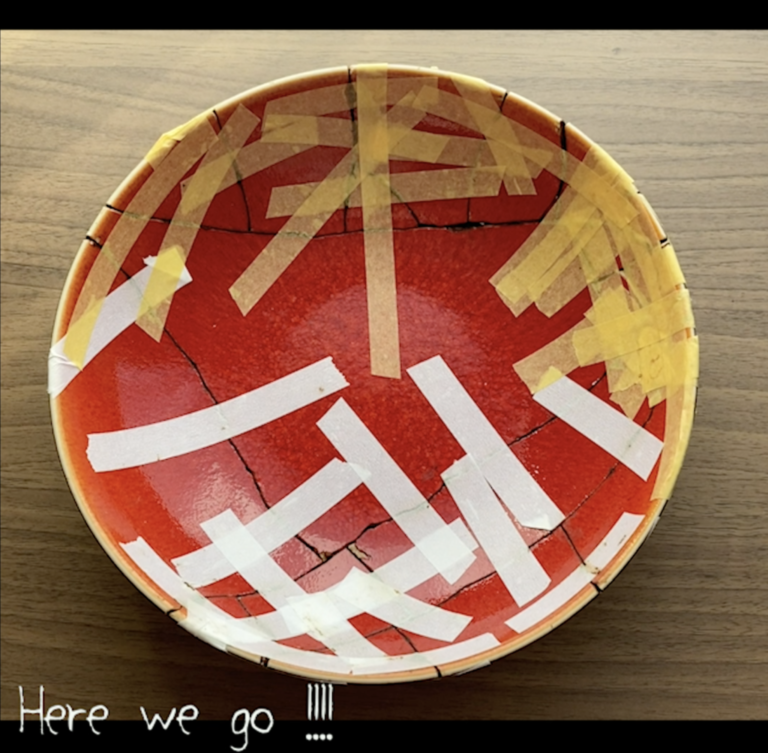The Broken Bowl
When Yuki Matano was doing her kintsugi training with her kintsugi master, she was always going to flea markets to find broken ceramics she could practice kintsugi with.
One day, she was given a large bowl from a friend. His son's hand had slipped when holding it, and the bowl landed on the floor, breaking into pieces. The bowl had a diameter of 25cm (9.84 inch) and was bright red.
Yuki's friend was French and it seems that the red bowl had been bought in France for a very affordable price (10-12 euros). The bowl did not have any particular sentimental value for him, but his son had cried a lot when he broke the bowl. He then had the idea of having the bowl repaired by Yuki. He was convinced that showing the result of the repair to his son would help develop his ecological consciousness.
Matano really liked her friend's way of thinking and so she accepted right away to take on the repair of the red bowl for free. She was very excited to see her friend's son's face when he would see the bowl repaired with kintsugi. She was pretty sure that he had never seen authentic kintsugi repair and saw it as a great opportunity to share the beauty of kintsugi with young people too.
At the time, very little did she know that this project would take her over a year to complete... When we say you need patience when doing kintsugi, we really do mean it.
Is There a Limit to the Number of Pieces That Can Be Put Back Together with Kintsugi ?
During our kintsugi workshops, a lot of students ask us if there is a limit to the number of pieces that can be put back together with kintsugi. The simple answer is that there is no limit. A more nuanced answer would be: as long as you have time and patience for it, there is no limit !
As the number of pieces increases, the level of the difficulty and the time you need to complete the repair also rise. The more pieces you have to stick back together the more chance you have to have gaps between the pieces. There is no secret recipe or shortcut if you want to do things right and have an optimal result. If you rush, the risk is to have uneven joints and surfaces, which will not look good, believe us.
Should Pieces Be Stuck One by One or All At Once ?
Since mugi-urushi takes a long time to harden, the number of times you apply mugi-urushi has a direct impact on the overall length of your repair project. Numerous of our students wonder if it is possible to stick all the pieces together or stick only two pieces at a time.
In our studio, we recommend as much as possible to stick only 2 pieces at a time. One reason is that, if you put all the pieces together in one go, you run a very high risk of having gaps and staining the object while applying mugi-urushi. If you are working on an object that is unglazed, you will not be able to remove the stains.
Another reason is that, if all the pieces are put together at the time, there is a great chance that the pieces may shift because of their weight while mugi-urushi hardens. If the object hardens in a bad position, it is very complicated to rectify it afterwards. In the case of the red bowl, it was necessary to apply a lot of masking tape to make sure that the pieces did not shift because they were very heavy. In order to take advantage of gravity, it is always good to place the restored joint parallel to the ground so that gravity pushes the two pieces further together.
When you put 2 pieces together at a time, it is easier to make sure the two pieces fit together without any gap. In addition, the risk of making stains is much lower.
Discover in Video The Repair Process of the Big Red Bowl
Yuki Matano gathered pictures and footage she took while restoring the big red bowl given by her friend. In total, it took her over a year to repair it.
Learn More About Kintsugi with Tsugu Tsugu !
At Tsugu Tsugu, we wish to share the beauty of traditional kintsugi with the world and help as many people as possible bring back to life objects they hold dear. In order to make kintsugi more accessible, we have created a kintsugi kit suitable for beginners and experienced learners of kintsugi.
Following increasing requests , we have opened two kintsugi studios in the heart of Tokyo, where we teach kintsugi and offer kintsugi repair services. Repair requests can be done at our studios (Ebisu and Asakusa) or through the flagship store of MUJI in Shinjuku, Tokyo.
In order to spread further knowledge about kintsugi, we have created a series of tutorials about kintsugi repair. Please check our Youtube channel for more tips about kintsugi repair !


1 comment
Hi, how much gold powder do you need to repair the badly broken bowl likes the one in your post? Also I live in the UK, will it be slightly cheaper if I order the kit directly with you (than on Etsy) and how much is the postage please? Thank you.